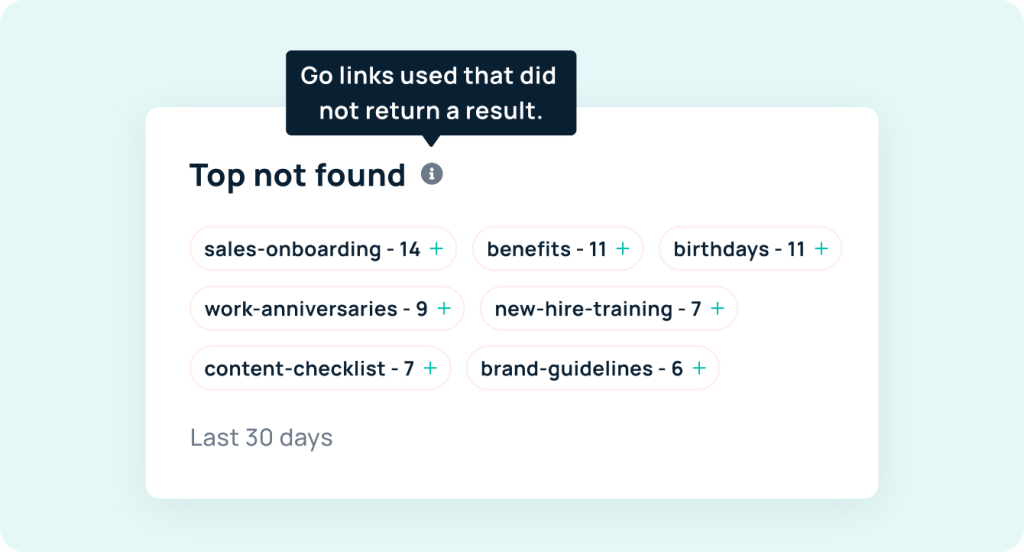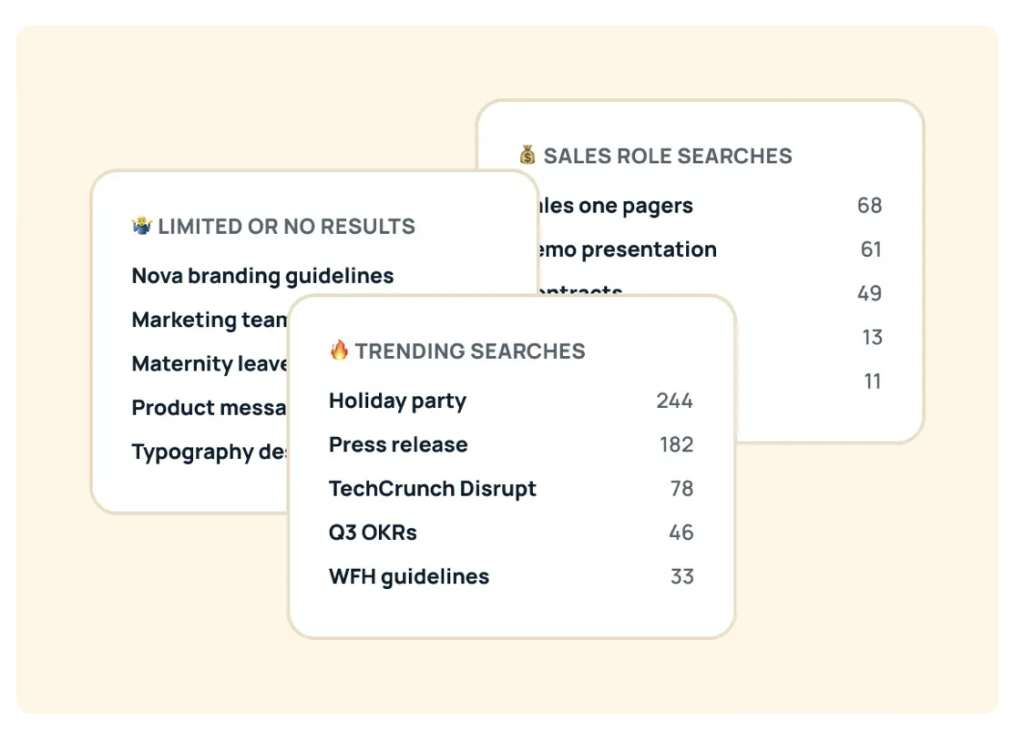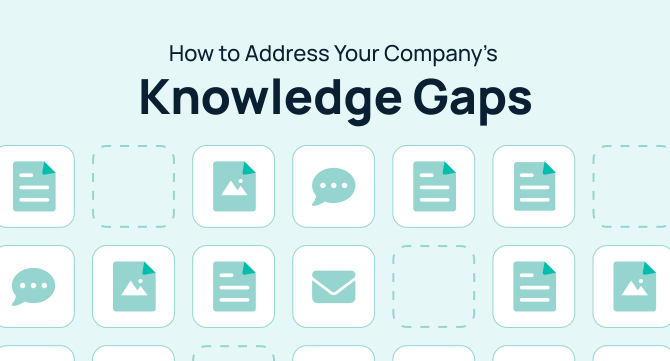Let’s say you’re new to a company and need to know how to reset your Google password.
You search your company’s intranet or resource repository for instructions on resetting your password, but you come up empty-handed.
This is a knowledge gap.
You decide to contact the IT team and ask them how you can reset your password. But the person you ask doesn’t know the answer.
This is also a knowledge gap.
Knowledge gaps like this can hinder productivity and hurt organizational performance.
In this article, we’ll discuss knowledge gaps, how they occur, their consequences, and strategies for effectively bridging them.
What is a knowledge gap?
Knowledge gap definition
A knowledge gap is the difference between the information or understanding that is available and what is required to solve a problem or achieve a goal. In an organizational context, this gap can hinder performance, decision-making, and overall success. Recognizing and addressing knowledge gaps is essential for tech professionals aiming to stay competitive and innovative.
Types of knowledge gaps
- Informational gaps
Informational gaps occur when there is a lack of factual data or information necessary to complete a task. This could include outdated market research, missing customer data, or insufficient technical documentation.
- Skill gaps
Skill gaps refer to deficiencies in specific skills or competencies required to perform a job effectively. For example, a team might lack expertise in the latest programming language or cybersecurity practices. According to this article, the U.S. talent shortage and skills gap could lead to a staggering $8.5 trillion loss by 2030.
- Cognitive gaps
Cognitive gaps arise from differences in understanding or interpretation of information. These can lead to miscommunication, errors, and inefficiencies within a team or organization.
How do knowledge gaps happen?
- Technological advancements: Rapid developments in technology can outpace an organization’s ability to keep up, creating gaps in knowledge about new tools, platforms, or methodologies. For instance, AI has been on the rise the last few years and companies that fail to adopt AI may struggle to keep up with competitors.
- Changes in industry standards: Evolving industry standards and best practices can leave organizations with outdated processes and information. For example, new regulatory standards for data security, such as GDPR, can render a company’s existing data management practices obsolete.
- Organizational changes: Mergers, acquisitions, and restructuring can disrupt the flow of knowledge within an organization and are a big reason gaps exist. For example, if you have experienced developers leave, the remaining staff may lack critical knowledge about ongoing projects and systems.
Why identifying knowledge gaps is crucial
Unaddressed knowledge gaps can have significant negative impacts on organizations:
- Inefficiencies: Teams may struggle to perform tasks efficiently without the necessary knowledge base, leading to increased costs and wasted resources.
- Poor decision-making: Decisions made without complete information can result in suboptimal outcomes and missed opportunities.
- Missed opportunities: Knowledge gaps can prevent organizations from capitalizing on new trends, technologies, and market opportunities.
How to identify and measure knowledge gaps
Surveys and assessments
Using surveys and assessments, organizations can gauge current knowledge levels and identify areas where information is lacking. This can include self-assessments, peer reviews, and formal testing.
Performance metrics
Analyzing key performance indicators (KPIs) helps identify areas for improvement during a gap analysis. Metrics such as project completion times, error rates, and customer satisfaction scores can highlight knowledge gaps.
Benchmarking
Comparing organizational performance against industry standards or competitors provides insights into potential knowledge deficiencies.
Feedback mechanisms
Gathering input from stakeholders and employees through feedback mechanisms, such as suggestion boxes, focus groups, and regular check-ins, can reveal areas where knowledge is lacking.
Software tools
GoLinks
GoLinks reveals knowledge gaps and helps prevent them by making knowledge more accessible within an organization. By analyzing employee searches, GoLinks identifies which links are being sought after. If a specific link that employees are searching for does not exist, GoLinks highlights this as a knowledge gap that needs to be addressed.

GoSearch
GoSearch helps both identify and prevent knowledge gaps by ensuring that employees have continuous access to up-to-date information, reducing the likelihood of knowledge deficiencies and enhancing overall organizational efficiency. Additionally, admins can review trending search results to pinpoint common areas where information is lacking.

Knowledge gap examples
Example 1: Technological advancements
In the fast-paced tech industry, knowledge gaps related to new technologies and trends are common. For instance, the rapid rise of artificial intelligence (AI) created significant knowledge gaps for many companies. Organizations had to quickly learn about AI algorithms, data processing techniques, and ethical considerations to stay competitive.
Example 2: Industry regulations
In sectors like healthcare and finance, regulatory changes are frequent and complex. Addressing gaps in knowledge related to new regulations and compliance requirements is crucial. For example, changes in data privacy laws such as GDPR required organizations to quickly update their knowledge and processes to remain compliant.
Example 3: Skills development
Consider a company that identified a skill gap in its development team related to cybersecurity practices. By implementing targeted training programs and leveraging GoSearch for continuous learning, the company improved its security posture, reduced vulnerabilities, and enhanced overall performance.
Strategies to address knowledge gaps
Start new training and development programs
Implementing targeted training and professional development initiatives is crucial. This can include workshops, online courses, and certification programs tailored to address specific knowledge gaps.
Here at GoLinks, we host monthly Link n Learns where employees share their expertise with coworkers. This is a fun learning experience for employees, and it helps reduce knowledge gaps across the organization,
Encourage knowledge sharing and collaboration
Encouraging a culture of knowledge sharing and using collaborative tools like GoLinks can help bridge knowledge gaps. GoLinks is a link-shortening tool that makes it easier for employees to find and share resources. For example, a long URL can become go/project or go/presentation. This facilitates easy sharing of information, ensuring that all team members have access to the latest knowledge.
Leveraging AI technology
Using AI-powered platforms, such as GoSearch, facilitates continuous learning and knowledge discovery. GoSearch uses generative AI to answer workplace questions and provide AI summaries. This allows employees to quickly find answers and access relevant information, helping to close knowledge gaps.
Improve your knowledge management with GoLinks
Closing knowledge gaps can make a huge difference for your company. By leveraging tools like GoLinks and GoSearch, tech professionals can ensure seamless knowledge flow within their organizations, paving the way for more growth and success.
For more insights on knowledge management and how to address common challenges, check out our articles on AI knowledge management and knowledge management challenges.
Access and share resources instantly with GoLinks
Schedule a demo














